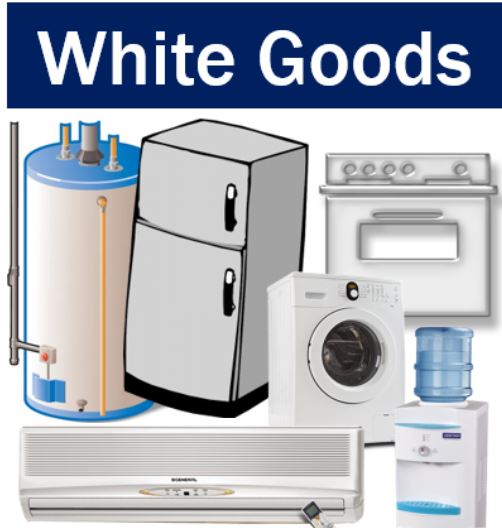White Goods are large home appliances such as stoves (British: cookers), refrigerators, freezers, washing machines, tumble driers, dishwashers, and air conditioners. They are large electrical goods for the house which were traditionally available only in white. Even though you can purchase them today in a wide range of different colors, they continue to be called white goods.
Major appliances – consumer durables made of enamel-coated sheet steel – are the same as white goods. These enamel coatings not only contribute to the durability of the appliances but also enhance their aesthetic appeal in modern home designs
The term may also refer to white fabrics, especially linen or cotton – articles such as curtains, towels, or sheets that historically used to be made of white cloth.
In the beverage industry, white goods are colorless spirits, such as vodka or gin.

White goods vs. brown goods
The term contrasts with brown goods, which are relatively light electronic consumer durables such as computers, digital media players, TVs and radios.
Definition: household appliances
The term household appliances refers to machines or devices that are in our homes and which we use to do jobs such as washing, cooling, heating, or cooking. Household appliances can be classified into:
– Consumer electronics (brown goods), such as TVs, computers, radios, or games consoles.
– White goods (major appliances) such as washing machines and refrigerators.
– Small appliances such as toasters, coffee makers, and blenders.
Regarding their maintenance and repair, brown goods typically require high technical skills and knowledge, while white goods generally require more ‘brute force’ and practical skills.
Durable goods and the Internet of things
White goods are slowly becoming inter-networked – collecting and exchanging data through the Internet. Most brown and white goods, as well as many small appliances, are expected to soon become part of the Internet of things – a global infrastructure for the information society, enabling the physical and virtual interconnecting of things.
Put simply, soon our homes will be full of smart devices, with Internet connections. The hardware in these devices will allow for communication with other appliances, automation, and more functionality.
The smart refrigerator, for example, senses what types of products are being stored inside; it keeps track of the stock through RFID or barcode scanning. The device is also able to tell you when items stored inside need to be thrown out because they have passed their sell-by dates.
Apart from creating shopping lists, smart fridges today can integrate each family member’s schedules, share pictures and send message directly to your smartphone. They can stream your favorite music, and even mirror TV shows.
Cyber-security experts worry that in future malicious software will be created to, for example, swing open the refrigerator door during the night, or raise the inside temperature so that all the perishables go rotten early.
Proofpoint Inc., a California-based cyber-security company, announced that it had discovered a large **botnet that infected smart refrigerators as well as other home appliances, and then delivered over 750,000 malicious emails.
** A botnet is a network of private computers infected with malicious viruses or worms and controlled as a group without the owners’ knowledge.
To counteract these threats, manufacturers are increasingly focusing on enhancing the security features of smart appliances to protect consumers from potential cyber attacks.
